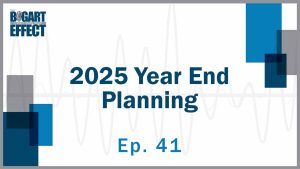When it comes to Roth Conversion Planning, many investors grapple with a multitude of questions. The process can seem daunting and complex, but understanding the nuances is essential for maximizing your retirement assets.
This comprehensive guide delves into the intricacies of performing a Roth conversion. We’ll explore how recent law changes have made these conversions more appealing and discuss the benefits and drawbacks of such an investment decision.
We will also provide insights on evaluating whether a Roth IRA conversion is right for you by considering factors like tax bracket shifts and traditional IRA assets. Furthermore, we’ll explain how our Bogart Wealth team uses specialized tools to make this critical financial planning decision.
The dynamic nature of yearly evaluations and adjustments in deciding the conversion amount into your Roth account will be addressed as well.
Lastly, concerns about taxes related to next-generation planning are not left out; we highlight strategies incorporating Roths to mitigate investor worries effectively.
This detailed exploration and understanding of Roth Conversion Planning aims to arm you with valuable knowledge so you can make informed decisions about your financial future.
Understanding Roth Conversions
Roth conversions: transferring money from a pre-tax source to a tax-free growing Roth. It’s like moving from a crowded bus to a private jet.
The process of performing a Roth conversion
Step 1: Decide to convert your funds from your current account to a Roth account.
Step 2: Pay taxes on the converted amount.
Step 3: Watch your funds grow tax-free in the Roth account.
It’s like planting money seeds in a tax-free garden.
Law changes that made Roth conversions more appealing
In 2010, income restrictions were removed for converting traditional IRAs to Roths. Now everyone can join the Roth party, regardless of income. Plus, taxpayers who converted in 2010 got a tax break spread over two years. It’s like getting a tax discount and a time machine.
Bogart Wealth knows the importance of customized financial planning services like investment management and tax preparation. Stay updated on strategies like Roth conversion planning. It’s like having a financial superhero in your corner.
Benefits of Performing a Roth Conversion
If you’re considering a Roth conversion, let’s explore the perks:
Tax Advantages of Roths
The main benefit of converting to a Roth is tax-free growth and withdrawals. Unlike traditional IRAs, qualified distributions from a Roth account are completely tax-free. Your investments can grow tax-free and stay that way in retirement.
Roths and Future Required Distributions
Roths can help reduce future required minimum distributions (RMDs). Traditional IRAs force you to take RMDs at age 72, potentially pushing you into a higher tax bracket.
With a Roth, there’s no such requirement during your lifetime, giving you more control over your retirement income planning.
Wealth Transfer Efficiency
Roth conversions also aid in efficient wealth transfer by reducing estate taxes for heirs and allowing them to receive a non-taxable inheritance. Funds can continue growing even after death, making it an effective tool for next-generation planning.
Consult a financial expert prior to executing a Roth conversion; everyone’s situation is different. At Bogart Wealth, we provide personalized advice based on each client’s unique circumstances using our detailed cash flow analysis tools.
Drawbacks of Performing a Roth Conversion
While this financial move has plenty of perks, it’s important to know the downsides too. One major drawback is that there’s no turning back once you convert to a Roth account.
The Irreversible Nature of Converting Funds into Roths
When you convert your assets into a Roth IRA, there’s no Ctrl+Z option. It’s a permanent decision. So, if the tides change or tax laws do a flip, tough luck. You’re stuck with your choice.
This lack of flexibility can be a real bummer. Life is an enigma, like a mystery box of sweets. You might face unexpected expenses or income changes and wish you could reverse the conversion. But alas, it’s not meant to be.
On top of being irreversible, there’s another tax-related downside. While your converted amounts grow tax-free and withdrawals in retirement are also tax-free (for now), the amount you convert counts as taxable income in the year it happens.
It’s like a double-edged sword, giving with one hand and taking with the other.
To top it off, you must pay taxes upfront at your current rate for the contributions made pre-tax. Since your contributions were originally made pre-tax, converting them means paying taxes upfront at your current rate.
It’s like paying for dinner before you even get to taste it. Partaking in the conversion of pre-tax contributions is no simple task, particularly if the amount involved is substantial.
Evaluating If A ROTH Conversion Is Right For You
Financial planning is like a puzzle – you need a customized approach to fit your situation’s unique pieces. One strategy to consider is the Roth conversion.
Is it the right choice to make? At Bogart Wealth, we crunch the numbers and use fancy tools to help you make an informed decision.
Factors That Influence ROTH Conversion
Determining if a Roth conversion is beneficial requires consideration of one’s current tax rate, potential future tax rates, proximity to retirement, and ability to cover taxes with non-retirement funds.
The general rule is if you expect your tax rate to be higher in retirement, a Roth conversion could save you some dough.
Tools We Use to Evaluate ROTH Conversion
At Bogart Wealth, we have fancy cash flow analysis tools that project your finances until age 90. We look at things like income increases over time and the benefits of lower tax rates.
We also consider different scenarios, like what if the market tanks early in retirement or if you have unexpected expenses?
All these factors can impact your wealth after you’re gone, which is important for next-generation planning. Our goal is to maximize your wealth while minimizing risk.
We also assess the potential implications of estate taxes on your legacy objectives. Ensuring your financial future is secure and that your assets are distributed according to your wishes is paramount.
Yearly Evaluation and Adjustment of Amount to Convert into a Roth Account
At Bogart Wealth, we believe in strategic financial planning. That means we’re always adjusting our approach to Roth conversions. Your financial situation can change, and so should your conversion strategy.
Changing Dynamics Affecting Yearly Evaluation
Income levels, tax rates, and market conditions – they all fluctuate. So, we reevaluate the amount you convert into a Roth account each year. It’s about maximizing benefits and minimizing drawbacks.
We analyze factors like tax law changes and shifts in personal finances. Then, we adjust our advice to optimize your tax liabilities.
Wealth transfer planning is important too. By adjusting the amount converted each year, we help your retirement savings grow efficiently with minimized tax implications.
It’s not about converting maximum amounts every time. It’s about making smart decisions based on individual circumstances. That’s why the annual review is crucial.
A Customized Approach for Each Client
We don’t do one-size-fits-all. We consider unique aspects like age, risk tolerance, and expected return rate before suggesting a course of action.
Making Informed Decisions with Bogart Wealth
For the most informed decision regarding Roth conversions, seek professional guidance from experts like Bogart Wealth. They have the tools and knowledge to guide you effectively.
Concerns About Taxes and Next-Generation Planning
As an investor, you may find yourself grappling with two key areas of concern: taxation and next-generation planning. Navigating these complicated matters requires a well-thought-out strategy and meticulous preparation.
Fortunately, incorporating a Roth conversion into your financial plan can effectively address these concerns.
Addressing Investor Concerns Via Strategic Inclusion of Roths
The primary appeal of Roth IRAs lies in their tax advantages. With Roths, your money grows tax-free, so no additional income tax is owed when you withdraw funds during retirement – a significant benefit for tax-wary investors.
In terms of next-generation planning, Roth conversions also offer substantial benefits. Unlike traditional IRAs or 401(k)s, Roths do not mandate required minimum distributions (RMDs) during the owner’s lifetime.
This allows more wealth to remain in the account, potentially growing over time and providing a larger tax-free inheritance for heirs.
A well-executed Roth conversion strategy can leave behind more wealth for your loved ones while reducing potential estate taxes – making it an attractive option for comprehensive legacy planning.
Bogart Wealth, renowned for its customized financial plans tailored to individual needs and goals, provides guidance on incorporating this tool into your investment strategy based on detailed cash flow analysis up until age 90.
They understand that each year brings new dynamics affecting evaluation so advice could change annually depending on factors like income increases and tax rates.
To make informed decisions about whether a Roth conversion is right for you, consider seeking professional assistance from experienced advisors like Bogart Wealth.
Their expertise in taxation strategies and next-generation planning can help maximize growth potential while minimizing drawbacks associated with converting funds into Roths.
Seek Roth Conversion Planning With Bogart Wealth
Roth Conversion Planning is a crucial aspect of financial planning for many investors. The process may seem complex, but understanding its nuances is essential to maximize retirement assets.
This comprehensive guide provided by Bogart Wealth delves into the intricacies of Roth conversions, exploring recent law changes that make them more appealing and discussing the benefits and drawbacks of such a decision.
You should now have insights on evaluating whether a Roth IRA conversion suits your circumstances, considering factors such as tax bracket shifts and traditional IRA assets.
Bogart Wealth’s specialized tools aid in making this critical financial planning decision. The yearly evaluation and adjustment of conversion amounts into Roth accounts are emphasized to effectively adapt to changing financial dynamics.
Furthermore, concerns about taxes and next-generation planning are addressed, highlighting the strategic inclusion of Roths to mitigate such worries and optimize wealth transfer efficiency.
You should now have valuable knowledge to make informed decisions about your financial future.
For personalized advice and guidance in Roth Conversion Planning, seeking assistance from experienced advisors like Bogart Wealth can lead to tax-optimized strategies for the future.



